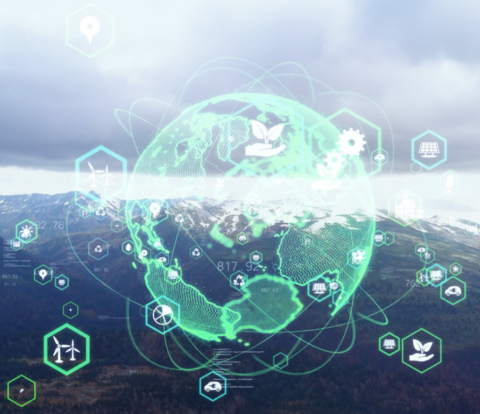
Written by
Published
Category
Researchers from Imperial Business School and the Singapore Green Finance Centre have used machine learning to combine data to understand the climate change risk at a local level
We know climate change will have a drastic impact upon the planet in the decades to come; worst-case-scenario global climate models predict rising seas, extreme heat and fiercer storms. But are these large-scale and complex models too blunt a tool to show how regions and countries will fare? Could we be doing a better job?
What are the current global climate models?
Global models are the main method scientists use to understand how climate may change in the future. But if these models don’t delve into enough physical detail at a local level, are small coastal communities and nations with microclimates and varied geography subject to inaccurate projections – and unfairly penalised by investors and insurers? Or if global models fail to flag urban hotspots where temperatures will soar high above regional averages, are we missing an opportunity to mitigate unforeseen climate shocks and save lives?
Using machine learning to build climate change models
What’s missing is a more in-depth understanding that could inform markets, investors and vulnerable communities. Using advances in computing muscle, we’ve created some science-based tools that allow a tighter analysis – and the results are surprising. We’ve focused on a group of countries in South East Asia, in a piece of research supported by the Singapore Green Finance Centre.
We’ve deployed machine learning to combine data from the most up-to-date global climate projections with information about regional topography and microclimates, and historical weather patterns. This has allowed us to disentangle data formerly lumped together to produce blanket national climate risk scores. Using these tools, what appears on a national map as a uniform risk, we now understand in finer resolution.
And this analysis has thrown up some results that differ significantly from those projected by global models – not only in average climate risks but also in the likelihood and severity of extreme events, such as rainfall, coastal flooding and typhoons. In some cases, global models overestimate these risks, and in others, they’re too optimistic.
Looking at results from new climate change models
For this research, we focused on four countries: Indonesia, Malaysia, the Philippines and Thailand. These are nations with densely populated coastlines, and renowned for extreme rainfall driven by local monsoons. We looked at projections for temperature, wind speeds, rainfall and coastal surges.
Our analysis reveals the impact of global warming will be uneven, even at a local level. Global projections of rainfall in urban areas might be out by as much as 100 per cent, while temperature forecasts might differ by 80 per cent in some areas. We know how different modelling choices may result in wildly different future outcomes, but the local variations documented here pertain to individual models and are invisible in the coarser modelling. Rainfall, which is driven in this region by fluctuating local monsoons, is particularly difficult to forecast.
By design, climate models tend to be global: weather patterns require long horizons to be understood, and it’s extremely challenging when formulating future scenarios to look at individual geographies. But we have managed to examine the impact of climate change to a within a square kilometre and our tools can reveal even greater detail by using more computational power.
In some cases, global models overestimate these risks, and in others, they’re too optimistic
We use machine learning to explore a vast amount of data, including the lie of the land. A local hill or mountain range can shelter land from wind and hold up the clouds, for instance, while tree cover can lower urban temperatures. From these findings, we’ve been able to reconstruct a national average risk, as well as a better understanding of potential for climate extremes. Translated, this means we can identify whether floods or high winds are more likely to the north or south of a nation, for instance. This robust analysis could also be applied to other parts of the world with different geographies.
There are many private risk assessors that produce country-specific forecasts for the marketplace, but their methods are mostly opaque and there’s often a lack of detail or understanding of how they’ve reached their results. Countries and regions need robust and open information – that’s what these science-based tools can achieve. Our methodology can be fine-tuned and applied at scale; we want to advance the science of climate projections.
Using our model for climate change research
At Imperial Business School, there’s scope to collaborate with the wider scientific community to look at broader applications. Our model can be integrated with other climate science research to reveal in greater depth how risks of other climactic events will change, improving our understanding of the risk of wildfires, drought and flooding. In Indonesia, for instance, peat fires can release dangerously high levels of carbon; knowing the economic and climate risks here could have an impact on our willingness or ability to curb emissions.
In other work, we’ve directed our methods for risk assessment towards one of the most natural methods of capturing carbon: forests. Working with US-based startup Terraformation, we aim to assess the efficacy of forests at drawing down carbon and as potential assets for firms wishing to invest in carbon-based resources. We hope to lower the barriers to financing initiatives to restore forests around the world.
Economic impacts are only part of the story. By using a range of state-of-the art tools across different disciplines, we can build a more detailed and integrated picture and make the most of opportunities to act and mitigate climate impacts. Knowledge of what the world might look like in the face of climate change is in everyone’s interest.
This article draws on findings from "Downscaling of Physical Risks for Climate Scenario Design" by Enrico Biffis (Imperial Business School) and Shuai Wang (Princeton University).




